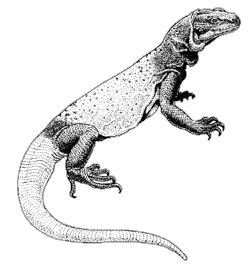Common Chuckwalla
(Sauromalus ater)
Order: Squamata
Family: Iguanidae (iguanid lizards)
Spanish name: chacahuala
Distinguishing Features
The chuckwalla is a large, bulky lizard reaching nearly 16 inches (40 cm) with folds of loose skin on the sides of its body. The color varies between sexes and with the age of the individual. Adult males have black heads and forelimbs; their trunks may be black, red, orange, gray, or yellow. Females and juveniles may have gray or yellow banding.
On the inside of the male’s thigh are well-developed femoral pores, which are small openings that allow secretions to be exuded. These secretions are thought to be a way of marking areas.

Range
A resident of southwestern deserts in the United States and Mexico, the chuckwalla is found in southeastern California, southern Nevada, southwestern Utah, western Arizona, eastern Baja California, and northwestern Mexico.
Habitat
Strictly a rock dweller, the chuckwalla is found in rocky outcrops, lava flows, and rocky hillsides of the Great Basin, Mohave and Sonoran deserts.
Life history
This herbivorous lizard emerges from hibernation in mid to late February, although it may be seen in rock crevices close to the surface on any warm winter day. During the active season, it emerges in the early morning to bask in the sun. It is active in temperatures as high as 102°F (39°C). When disturbed it seeks shelter in rock crevices and gulps air, wedging itself in a crack, thus making it extremely difficult for predators to extract it. During summer an average of 6 eggs are laid; hatchlings emerge in late September. The chuckwalla feeds mainly on annuals, but also eats perennials; it will consume insects on occasion.
Comments
If food resources are abundant, large male chuckwallas become territorial during certain parts of the year. Below the “tyrant”male, the other males will set up a dominance hierarchy based on size. When food is scarce, no territoriality is exhibited and some males form a hierarchy centered around food resources rather than the size of the animal. Often in these lean times, reproduction will not occur.










